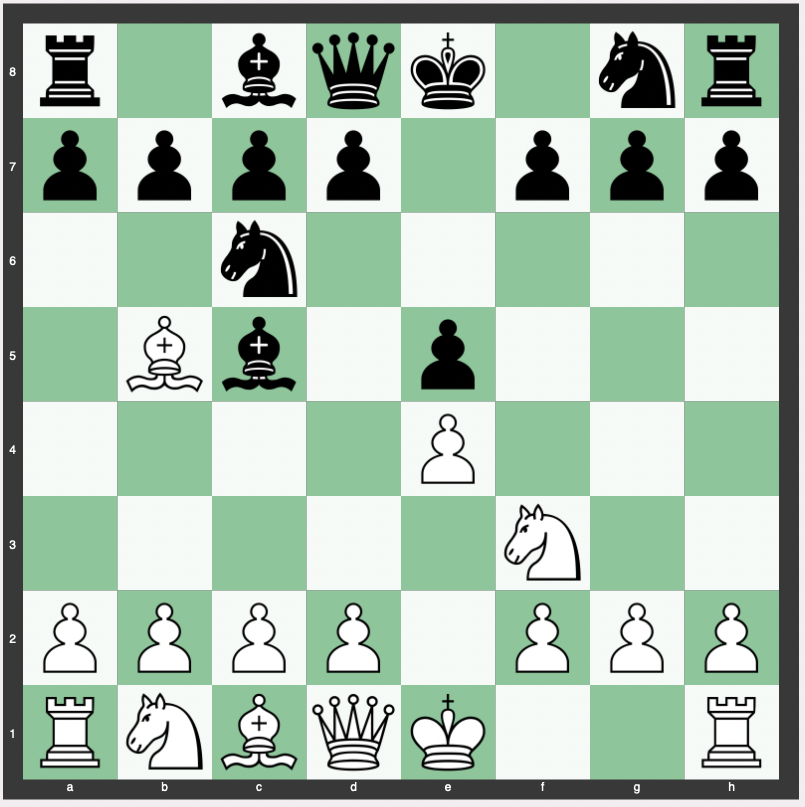The Classical or Cordel Defense is a non-traditional response to the Ruy Lopez, one of the most popular chess openings.
It represents a rich and complex battleground that has been explored by many great players throughout history.
This article will delve into the move order, theory, variations, history, suitability for different levels of players, and its frequency of play at the Grandmaster level.
Move Order Classical Defense in the Ruy Lopez
The Classical or Cordel Defense begins with the moves 1. e4 e5 2. Nf3 Nc6 3. Bb5 Bc5.

This sequence of moves sets the stage for a complex battle, with both sides having various options to continue the game.
Theory, Strategy, and Purpose of the Classical Defense
The Classical Defense aims to develop pieces quickly and put pressure on White’s center.
White’s most common reply is 4.c3, preparing to support the center with d4.
Black has several responses, leading to different types of positions, ranging from sharp tactical battles to more solid and strategic play.
Variations of the Classical Defense
There are several key variations in the Classical or Cordel Defense:
- The Cordel Gambit: 4…f5, leading to sharp play, with 5.d4 considered the strongest reply.
- The Benelux Variation: A more solid approach with 4…Nf6, followed by 5.0-0 0-0 6.d4 Bb6.
- Transposing to the Classical Berlin: With 4.0-0, Black can play 4…Nf6.
- The Fork Trick: An alternative for White is 4.Nxe5, leading to tactical complications if Black captures the knight with 4…Nxe5 5.d4.
Sample continuation lines include:
4. c3 Nf6 5. d4 exd4 6. e5 Ne4 7. O-O d5 8. cxd4 Bb6 9. Nc3 O-O 10. h3 Bf5 11. Na4 h6 12. Be3 Ne7 13. Bd3
4. c3 Nf6 5. d4 exd4 6. e5 Ne4 7. O-O d5 8. cxd4 Bb6 9. Nc3 O-O 10. h3 h6 11. Be3 f5 12. exf6 Rxf6 13. Ne5 Ne7 14. Bd3 Bf5 15. Na4 Nd6
4. c3 Nf6 5. d4 exd4 6. e5 Ne4 7. O-O d5 8. exd6 O-O 9. Bxc6 bxc6 10. dxc7 Qxc7 11. cxd4 Bb4 12. a3 Bd6 13. Nbd2
4. c3 Nf6 5. d4 exd4 6. O-O dxc3 7. e5 Ng4 8. Nxc3 O-O 9. Bg5 Be7 10. Bxe7 Nxe7 11. h3 Nh6 12. Re1 Ng6 13. Bc4 Nf5 14. Qd2 d6 15. Rad1 Be6 16. Bxe6 fxe6 17. exd6 Qxd6 18. Ng5 Qxd2 19. Rxd2 Rad8 20. Rxd8 Rxd8 21. Nxe6 Rd2 22. Nxc7 Rxb2
It is evaluated approximately +0.70 for white.
History of the Classical Defense
The Classical or Cordel Defense (ECO C64) is possibly the oldest defense to the Ruy Lopez.
It has been played occasionally by former world champion Boris Spassky and Boris Gulko.
Its historical roots and rich tactical nature have made it a subject of study and play for centuries.
Is the Classical Defense Good for Beginners or Intermediates?
The Classical or Cordel Defense can be suitable for both beginners and intermediate players.
For beginners, it offers a straightforward development plan and opportunities to learn key tactical and strategic concepts.
Intermediate players may find the variations and complexities of this defense an exciting challenge to explore.
How Often Is the Classical Defense Played at the Grandmaster Level?
While not as popular as some other defenses against the Ruy Lopez, the Classical or Cordel Defense has been employed at the Grandmaster level.
Its rich tactical nature and strategic depth make it an interesting choice for players looking to explore less-trodden paths in the opening.
Conclusion
The Classical or Cordel Defense is a venerable and intriguing response to the Ruy Lopez, offering a wide range of strategic and tactical possibilities.
Its historical significance, variations, and adaptability to different levels of play make it a valuable addition to any chess player’s repertoire.
Whether you’re a beginner looking to learn fundamental concepts or an intermediate player seeking new challenges, the Classical or Cordel Defense provides a rich and rewarding chess experience.


